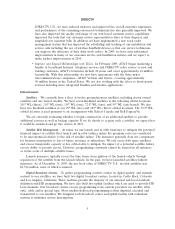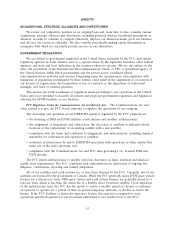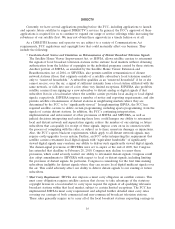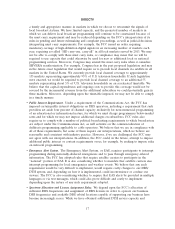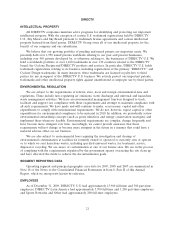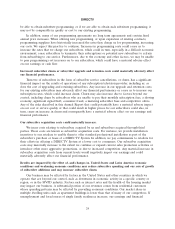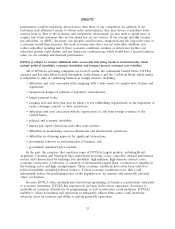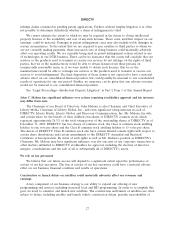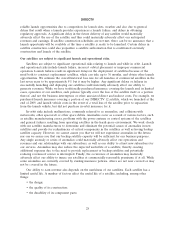DIRECTV 2009 Annual Report Download - page 31
Download and view the complete annual report
Please find page 31 of the 2009 DIRECTV annual report below. You can navigate through the pages in the report by either clicking on the pages listed below, or by using the keyword search tool below to find specific information within the annual report.DIRECTV
term is defined by the ITU. We have opposed this proposal, and believe that tweener satellites
as proposed by applicants would cause interference to our current and planned operations and
impose a significant constraint on the further growth of our DIRECTV U.S. DBS service. We
cannot predict what if any action the FCC may take or the effect of such a proceeding on our
business.
On November 29, 2006, despite the pendency of the tweener satellite rulemaking and over our
opposition, the FCC’s International Bureau granted Spectrum Five’s application to operate a
tweener satellite at the 114.5o WL orbital location, only 4.5o away from our DBS satellites
operating at the 110o WL and 119o WL orbital locations. While the Bureau limited Spectrum
Five’s operations to levels below those at which the ITU deems one DBS system to ‘‘affect’’
another in the absence of agreement from all affected DBS operators (including us), the
Bureau’s grant of Spectrum Five’s application prior to coordination could ultimately permit
Spectrum Five to operate at levels that would cause interference to our operations. On
February 1, 2008, the full FCC denied reconsideration of the International Bureau’s order, but
clarified that, if Spectrum Five is unable to coordinate its tweener satellite, it must file for a
modification of its authorization and demonstrate that its proposed operational parameters
would not exceed the ITU trigger for coordination. To date, Spectrum Five has neither
contacted us to attempt coordination of its tweener system nor filed for modification of its
authorization as directed by the FCC.
The FCC has also adopted rules that require satellite operators to take certain measures to
mitigate the dangers of collision and orbital debris. Among other things, these rules impose
certain requirements for satellite design and end-of-life disposal maneuvers for all satellites
launched after March 18, 2002, which apply to eight of our in-orbit satellites. We believe that we
are in compliance with all of these requirements and expect that we will continue to be able to
comply with them going forward, but the requirements for end-of-life disposal could result in a
slight reduction in the operational life of each new satellite.
•Geographic Service Rules. The FCC requires DBS licensees to comply with certain geographic
service obligations intended to foster the provision of DBS service to subscribers residing in the
states of Alaska and Hawaii. We believe that we are in compliance with these rules although, in
the past, some have argued otherwise to the FCC. The FCC has not acted on petitions filed
several years ago by the State of Hawaii and an Alaska satellite television dealer. We cannot be
sure that the FCC will agree with our view that we are in compliance with the agency’s
geographic services rules, or that the FCC will not require us to make potentially cumbersome
and costly changes to our offerings. The FCC has also adopted similar rules for the 17⁄24 GHz
BSS service.
•FCC Conditions Imposed In Connection With the Liberty and News Corporation Transactions. In
approving Liberty’s 2008 acquisition of News Corporation’s equity investment in us, the FCC
imposed a number of regulatory conditions on us and Liberty, some of which directly or
indirectly affected our business. In granting authority for the merger of Liberty
Entertainment, Inc. and DIRECTV in 2009, the FCC conditioned its approval of the transaction
on continued compliance with those conditions. Accordingly, the FCC has imposed on us
program carriage conditions intended to prevent discrimination against all forms of unaffiliated
programming; and certain program access conditions intended to ensure non-discriminatory
access to much of the programming carried on the DIRECTV service. In particular, we may be
required to submit to ‘‘baseball style’’ arbitration if we cannot arrive at terms for carriage of our
regional sports network programming with an MVPD. We cannot predict what effect our
compliance with or the FCC’s enforcement of these conditions will have on our business.
19


